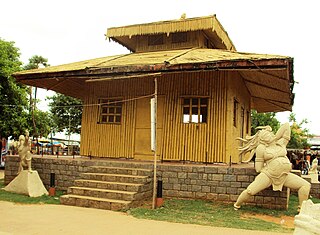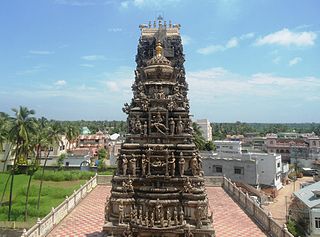
Parnasala is a village in the Dummugudem mandal in the newly formed Bhadradri Kothagudem district of Telangana, India. The village is accessible by road and boats and is situated 32 km from the temple town of Bhadrachalam.

Kapaleeshwarar Temple is a Hindu temple dedicated to lord Shiva located in Mylapore, Chennai in the Indian state of Tamil Nadu. The form of Shiva's consort Parvati worshipped at this temple is called Karpagambal is from Tamil. The temple was built around the 7th century CE and is an example of Dravidian architecture.

Bhadrachalam is a census town in the Indian state of Telangana, Bhadradri Kothagudem district. It is an important Hindu pilgrimage town with the Bhadrachalam Temple of Lord Rama, situated on the banks of Godavari river. It is located 312 kilometres (194 mi) from east of state capital, Hyderabad,115 kilometres (71 mi) from Khammam,192 kilometres (119 mi) from Vijayawada,177 kilometres (110 mi) from Suryapet, 180 kilometres (112 mi) from Warangal, 220 kilometres (137 mi), from the Andhra Pradesh State Capital Amaravathi, 350 kilometres (217 mi) from Visakhapatnam.

Sri Varaha Lakshmi Narasimha temple, Simhachalam is a Hindu temple situated on the Simhachalam Hill Range, which is 300 metres above the sea level in Visakhapatnam, Andhra Pradesh. It is dedicated to Vishnu, who is worshipped there as Varaha Narasimha. As per the temple's legend, Vishnu manifested in this form after saving his devotee Prahlada from a murder attempt by the latter's father Hiranyakashipu. Except on Akshaya Trutiya, the idol of Varaha Narasimha is covered with sandalwood paste throughout the year, which makes it resemble a linga.
Kancharla Gopanna, popularly known as Bhakta Ramadasu or Bhadrachala Ramadasu, was a 17th-century Indian devotee of Lord Rama and a composer of Carnatic music. He is a famous Vaggeyakara from the Telugu classical era. He lived in the village of Nelakondapalli, near the town of Bhadrachalam, in Muslim-ruled Telugu country during the 17th century and is renowned for constructing a famous temple for Lord Sri Rama at Bhadrachalam. His devotional lyrics to Rama are famous in South Indian classical music as Ramadaasu Keertanalu. Even the doyen of South Indian classical music Swami Tyagaraja learned his musical compositions. He also wrote Daasarathi Satakamu with a 'makuTamu' (మకుటము) 'Daasarathee Karunaa payonidhee', a collection of nearly 108 poems dedicated to the son of Dasaratha.

Sri Ramadasu is 2006 Indian Telugu-language hagiographical film, based on the life of musician saint Kancharla Gopanna, produced by Konda Krishnam Raju on Aditya Movies banner and directed by K. Raghavendra Rao. Starring Akkineni Nageswara Rao, Akkineni Nagarjuna, Suman, Sneha and music was composed by M. M. Keeravani. Cinematography and editing were handled by S. Gopal Reddy and Sreekar Prasad respectively. Upon release, the film got positive reviews.

Venkateswara Temple is a Hindu temple situated in the hill town of Tirumala at Tirupati in Chittoor district of Andhra Pradesh, India. The temple is dedicated to Venkateswara, a form of Vishnu, who is believed to have appeared here to save mankind from trials and troubles of Kali Yuga. Hence the place has also got the name Kaliyuga Vaikuntha and the Lord here is referred to as Kaliyuga Prathyaksha Daivam. The temple is also known by other names including Tirumala Temple, Tirupati Temple, Tirupati Balaji Temple. Venkateswara is known by many other names: Balaji, Govinda, and Srinivasa. The temple is run by the body Tirumala Tirupati Devasthanams (TTD) which is under direct control of the Andhra Pradesh Government, which also appoints the head of TTD and uses the revenue from the shrine.
Sri Venkateshwara Swami Temple is a landmark vaishnavite temple situated in the hill town of Tirumala at Tirupati in Chittoor district of Andhra Pradesh, India. The Temple is dedicated to Lord Venkateswara, an incarnation of Vishnu, who is believed to be appeared here to save mankind from the trials and troubles of Kali Yuga.

Thirukkadigai or Sholingapuram in Sholinghur, a village in Vellore district of the South Indian state of Tamil Nadu, is dedicated to the Hindu god Vishnu. Constructed in the Dravidian style of architecture, the temple is glorified in the Divya Prabandha, the early medieval Tamil canon of the Azhwar saints from the 6th–9th centuries AD. It is one of the 108 Divyadesam dedicated to Vishnu, who is worshipped as Lakshmi Narasimhar and his consort Lakshmi as Thirumamagal. There are three separate shrines in the form of Narsimha, Bhaktavatsala Perumal and Hanuman (Anjaneya). They are situated on the larger hill, at the base of the larger hill and on the smaller hill respectively.

Devaadi Raja Perumal temple (தேவாதிராஜன்) in Therazhundur, a village in Mayiladuthurai district of the South Indian state of Tamil Nadu, is dedicated to the Hindu god Vishnu. Constructed in the Dravidian style of architecture, the temple is glorified in the Divya Prabandha, the early medieval Tamil canon of the Azhwar saints from the 6th–9th centuries AD. It is one of the 108 Divyadesam dedicated to Vishnu, who is worshipped as Amaruviappan and his consort Lakshmi as Sengamalavalli Thayar. The original structure of the temple was built by the Karikala Chola during the 1st century CE, with later additions from the Cholas during the 11th century.

Rama Navami is a Hindu spring festival that celebrates the birthday of Rama, the seventh avatar of the god Vishnu. Rama is particularly important in the Vaishnavite tradition of Hinduism. "Hazaribagh's Ram Navami" show is international. The festival celebrates the descent of Vishnu as the Rama avatar, through his birth to King Dasharatha and Queen Kausalya in Ayodhya. The festival is a part of the spring (Vasanta) Navratri, and falls on the ninth day of the bright half of Chaitra, the first month in the Hindu calendar. This typically occurs in the Gregorian months of March or April every year. Rama Navami is an optional government holiday in India.

Sri Kodandaramaswamy Temple is one of the famous temples, after Tirumala Venkateswara Temple, in the holy city of Tirupati in Chittoor district of Andhra Pradesh, India. The temple is dedicated to Lord Rama an incarnation of Vishnu along with Sita and Lakshmana. The temple also has a sub-shrine for Anjaneya the mount of Lord Sri Rama.
The following is a list of temples in Telangana:
Telangana State Tourism Development Corporation (TSTDC) is a state government agency which promotes tourism in Telangana, a state in the Southern region of India. The retired Director General of Police Pervaram Ramulu is the appointed First chairman of Telangana State Tourism. Tourist attractions in Telangana include historical places, monuments, forts, water falls, forests and temples.

The Culture of Telangana in India has a cultural history of about 5,000 years. The region emerged as the foremost centre of culture in Indian subcontinent during the rule of Kakatiya, the Qutb Shahi and Asaf Jahi dynasties—. The rulers' patronage and interest for arts and culture transformed Telangana into a unique multi-cultural region where two different cultures coexist together, thus making Telangana the representative of the Deccan Plateau and its heritage with Warangal and Hyderabad being its epicenter. The regions' major cultural events celebrated are "Kakatiya Festival" and Deccan Festival along with religious festivals Bonalu, Bathukamma, Dasara, Ugadi, Sankranthi, Milad un Nabi and Ramadan.

Padalathri Narasimhar Temple or Narasimhar Temple is dedicated to Hindu god Vishnu (Narasimhar) located in Singaperumal Koil, near Chennai City, in the South Indian state of Tamil Nadu. Constructed in the Rock-cut architecture, dedicated to Vishnu, who is worshipped as Narasimhar and his consort Lakshmi as Ahobilavalli, the temple was built by the Pallavas during the 8th century. Earlier in Kanchipuram district, it is now under Chengalpattu district.
Sri Venugopalaswamy Temple is a Hindu-Vaishnavite temple situated at Karvetinagaram in, Chittoor District of Andhra Pradesh state, India. The Temple is dedicated to Lord Krishna, ninth incarnation of Vishnu's Dasavatharam, who is referred to as Venugopala. It is situated at a distance of 58 km from Tirupati and 12 km from Puttur.

Hare Krishna Golden Temple is located at Banjara Hills, Hyderabad, India. It is the first Golden Temple to be constructed in Telangana. It was inaugurated in 2018 by Vice President of India Sri Venkaiah Naidu.

Sitamma Sagar Barrage is a proposed barrage across Godavari River with run-of-river hydroelectric power project at Dummugudem village, Bhadradri Kothagudem district in Telangana. The project is proposed at about 200 meters downstream of the existing Dummugudem anicut built about 150 years ago.

Kodandarama Temple is a Hindu temple located in Gollala Mamidada in East Godavari district of Andhra Pradesh, India. The temple is dedicated to Rama, the seventh incarnation of Vishnu. It was built on the banks of Tulyabhaga (Antharvahini), a tributary of Godavari. The temple is notable for its unique architecture and two huge gopurams which stand at 160–170 feet and 200–210 feet. The temple gopurams are adorned with intricately carved statues depicting scenes from Ramayana, Mahabharata, and Bhagavatam.




























